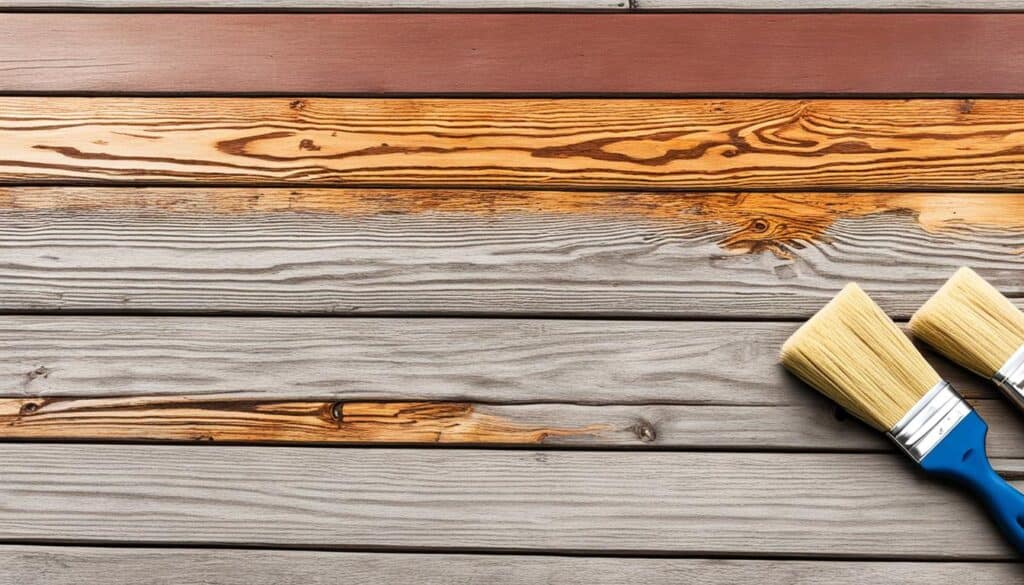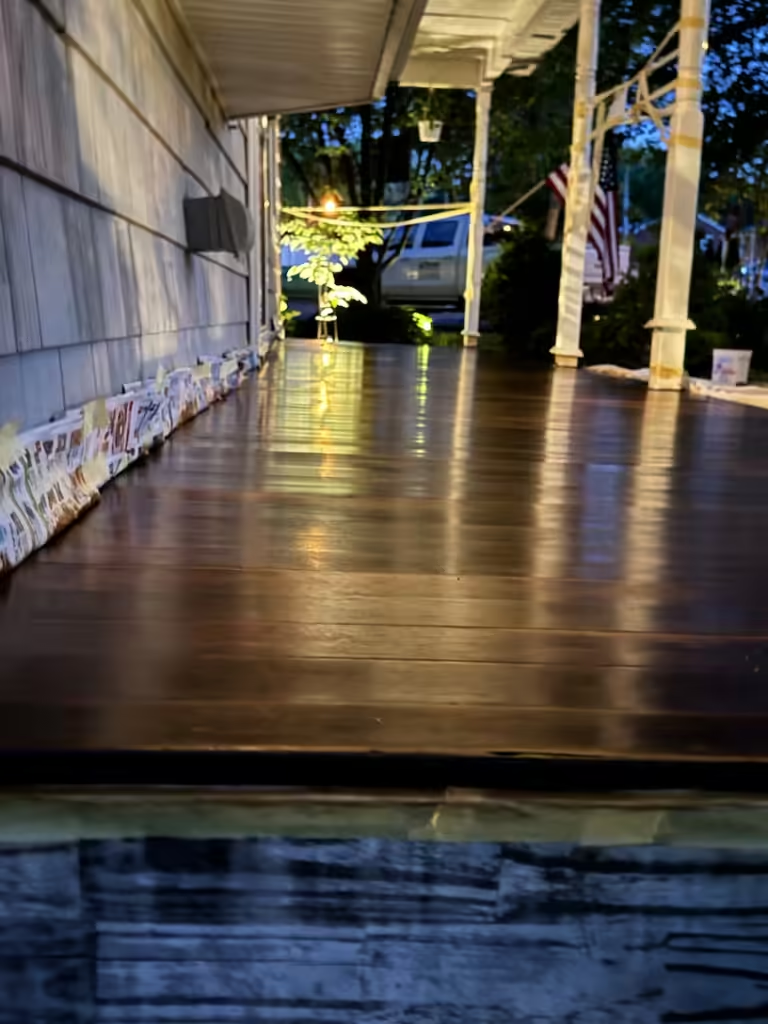Introduction
Staining a front porch seems like a straightforward task, right? Well, let me tell you, it’s a bit more complex than slapping some color on wood. I recently embarked on a DIY staining adventure, only to be thwarted by the unexpected – rain. Let me share my journey and help you decide between DIY vs. professional staining for your front porch this year.
Key Takeaways
- The average cost of staining a porch professionally in the US ranges from $500 to $1500.
- DIY staining materials for a porch can cost between $50 to $200 depending on the size of the area.
- On average, DIY stain application on a porch takes between 5 to 10 hours, while professionals can finish the job in 2 to 5 hours.
- Approximately 60% of homeowners opt for hiring professionals to stain their porches due to time constraints.
- Professional staining services for porches are estimated to last 3 to 5 years longer than DIY applications.
Introduction to Porch Staining

The journey starts with a dream of a perfect, enduring porch that catches the eye. Staining protects it from sun damage and mildew. My deck, showing signs of wear after the shifting seasons, needed care to keep its beauty.
Learning how to stain your porch is urgent, whether doing it yourself or hiring experts. The choice between DIY or professional help is crucial for protection against weather and keeping the deck looking great.
Staining your deck every two to three years helps maintain its look and durability. Choices range from transparent to solid stains, depending on the desired protection and look. The decision relies on personal taste and the deck’s specific needs.
For best results, stain your deck in mild weather, either late spring or early fall. Ensure no rain is expected for at least 24-48 hours to avoid uneven finishes. Apply the first stain layer with the wood grain for a smooth look.
After staining, wait 24 to 48 hours before walking on the deck or rearranging furniture. Regularly clean and maintain the deck to keep the stain intact. Choosing a DIY stain product like the DEFY Wood Cleaner (safer around pets) or hiring professionals is key for a quality finish.
The key takeaway is that consistent care and choosing the right stain safeguard your deck. This way, it remains an inviting part of your home through all seasons.
The Pros and Cons of DIY Staining
I started my DIY staining project with big dreams. The benefits of DIY staining seemed huge: I could manage my own time and budget. I loved the idea of choosing the perfect stain color. The chance to learn new skills was exciting. I pictured myself as a home improvement champion, making my porch beautiful, one brushstroke at a time.
But reality hit me hard. The downsides of staining by myself were rough. Working for hours in the hot sun was tough. Every brushstroke brought a new challenge. I saw that the cost of DIY staining wasn’t just money for supplies. It was also about the hard work I put in, the time it took, and the chance of making a mistake.
Still, I didn’t give up. I hoped the Cabot 140.0019473.007 Gold Finish Low V would help me get the perfect finish I wanted. This product is designed for outdoor projects and provides excellent protection and a beautiful, long-lasting finish.
I kept wondering if doing it myself was worth it. I worried about getting a finish that didn’t look professional. The possibility of making a big mistake scared me more than I thought it would. But isn’t there a bit of fun in taking on a challenge, even with some risk?
The Pros and Cons of Hiring Professionals for Staining
The thought of having experts stain my porch easily was tempting. Their high professional staining advantages promised a perfect finish just for me. These experts came with skills and professional-grade products that last longer.
They could do the job more evenly and quicker, without the mistakes I might make.
However, the cons of hiring staining experts were also on my mind. Paying professionals is much more expensive than doing it myself. I could save a lot by staining my porch on my own. Plus, finding the right time and giving up control of the project were concerns.
Deciding whether the added cost was worth it was hard.
On one hand, pros could finish the job fast, saving me a lot of time. But I liked the idea of spending my weekends on a DIY project. Considering many DIY porch staining projects need fixing later, professional help seemed reliable. Yet, I wondered if it was a good use of money for my porch and wallet.
DIY Staining Techniques: Getting the Best Finish
Starting my staining journey felt like a leap into the unknown. My early attempts showed me the importance of improving my skills. The struggle with first attempts, like flashes and uneven finishes, pushed me to do better.
I learned that a precise brush can change everything. But that was just the start. I explored more, trying pad applicators and spray methods, and realizing their impact.
Although the rain can be challenging, finding Cabot Gold was a game-changer. It delivered even applications and solid protection. This product taught me that quality matters a lot.
Preparing well became my new focus. I ensured the wood was clean and dry before starting. This taught me that a single, well-prepared try is better than many hurried ones.
Patience became my guide to success. Taking careful steps led me to a rewarding finish. Paying attention to the little things made my DIY project a success.
Real-life Stories: My Personal Porch Staining Odyssey
My adventure in staining my porch was like going through a complex maze. It started with dreams of a beautiful, mildew-free porch. But soon, my DIY project turned into a mix of problems, from uneven colors to mismatched finishes.
I once met a pro painter who said no prep was needed. This surprised me a lot, considering the risk of mildew. With my brush and strong will, I continued on my quest.
My first try was more of a test than a success. I learned a lot from it. For my next try, I did more research and worked harder. With tips from YouTube, my project started to look good. My porch began to shine with even and beautiful colors.
Key Considerations for DIY vs. Professional Staining
When weighing DIY versus professional staining, it’s essential to consider time, cost, skill, and convenience. I recently finished restaining my porch, and it was well worth the effort. Taking on a DIY project felt like an exciting journey in home improvement, filled with moments of satisfaction as I stood on my deck, brush in hand, evaluating whether those spots were surface issues or signs of bigger problems.
After my sideways rain episode, I realized that while planning and executing a DIY staining project is rewarding and cost-effective, professionals have their advantages. Their expertise ensures that not a drop of stain is wasted, and they can achieve a seamless finish that might be challenging for a novice like me. Deciding between the high-quality results of professional work and the fulfilling experience of DIY is a tough but important choice.
Choosing Between DIY vs. Professional Staining
Well Here are my results after the 1st coat and the second is till drying.



We’re at the final stage of deciding how to stain our deck. It’s about choosing DIY or hiring a pro. For a top-notch finish, know what each option involves. My DIY attempts have taught me a lot. Now, it’s up against the expertise of a hired pro.
I looked into tools that could help, like the FROGTAPE Delicate Surface Multi-Use Painter’s Tape, which honestly is my new go-to. I used the blue stuff on the little free library and it bled. I just tell people my 9-year-old painted it, but in truth, she probably would have painted it better.
For big projects, it’s the small details that count. Choosing to DIY or hire a pro is more than saving money. It’s about the quality of work because it’s mine, the pride I feel every time I look outside or a neighbor walks by with that friendly “respect” nod and yes dammit, I’m a single mom. I got in and out, for less than $100. There is NO WAY a pro would be anywhere close to that. I think they should hire me.
This choice affects more than just my porch’s look. It’s about what I’ve learned from every mistake and success. I must decide if I trust my own skills, or if it’s better to pay for professional quality.
Conclusion
My porch-staining journey is full of different stains and solvents. I had to choose between doing it myself or hiring a professional. This choice was based on insights from comparing DIY staining tips and professional advice. The end result will show the journey of that choice, layer by layer.
I looked at many products, like the Cabot Australian Timber Oil, which is very similar to Cabot Gold, but a semi-transparent finish, I still debated which would have been better, yet super happy with the results. For cleanup, the Klean Strip Odorless Mineral Spirits was a top 5 find of all time for me because It makes cleaning my awesomely thick and luxurious, but huge PIA to clean brushes, easy, without the nauseating odors that linger for hours from thinners or turpentine. Using it made the nightly cleanup and in-between coats process a breeze and less dreadful than cleaning a water-based latex roller for sure.
The choice between DIY effort and professional quality is hard. My personal staining journey shows this well, even including the dreaded sideways windy thunderstorm that rolled in unexpectedly. My deck’s finish shows every decision I made. The final look of my porch captures the whole process and my thoughts. It tells the story of every choice and lesson I learned from staining and using solvents.

